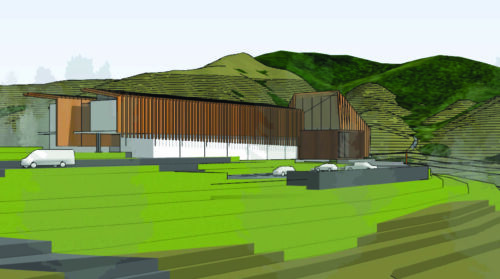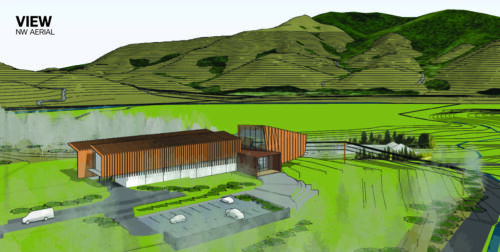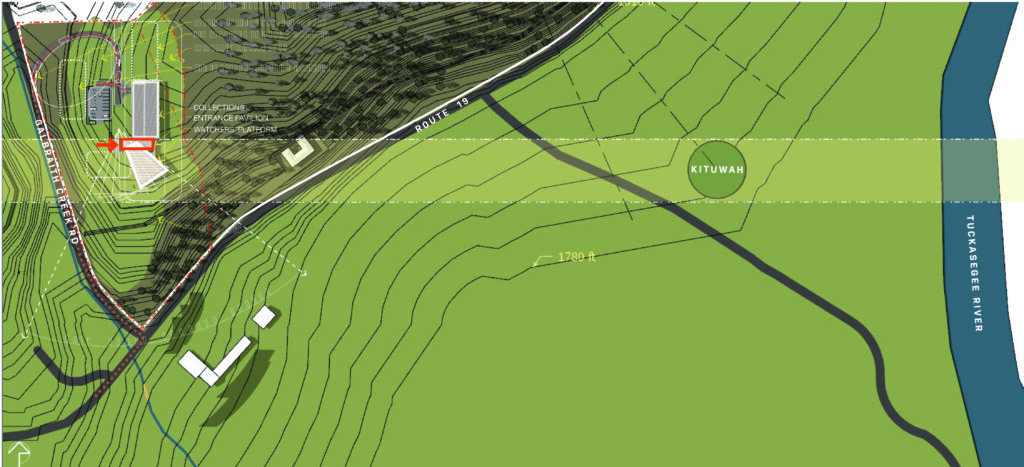By SCOTT MCKIE B.P.
One Feather Asst. Editor
KITUWAH – A facility to house historical collections of the Eastern Band of Cherokee Indians is moving forward. Currently in the early planning stages, the Off-Site Collections Facility (a working name only) will be built at the Kituwah site.
Shana Bushyhead Condill, Museum of the Cherokee People executive director, said the Collections Facility has been a project she’s been thinking about since she started in 2021. “I started sort of asking folks about it. I sort of got a few laughs and ‘well, we’ve been trying to do that for decades’…so we started doing the research and pulling up resolutions and we found ten that had gone in front of Council since 1994.”

This conceptual drawing, per hickok cole architects, shows what the new Off-Site Collections Facility (working name only) could look like. The project is in the early research and development phase.
“So, as we were pulling research from people who had been working on this project before, then we could sort of say, ‘yes, ya’ll have gotten so far. Let’s see if we can push it further down the line.’ So, we went to Council and were able to get that 37 acres over by Mother Town designated to the Museum. That was a big step for us.”
Condill added, “What it sounded like for us is that it just needed somebody to champion it. So, for the Museum, of course it’s a perfect fit. We’re the repository of the Eastern Band of Cherokee Indians and it makes sense for the Museum to take on that project.”
The project has been a long time coming.
With the passage of the Eastern Band of Cherokee Indians Land Exchange Act of 2003 on Nov. 10, 2003, the Tribe exchanged 218 acres, known as the Yellow Face tract, with the National Park Service for the Park’s 143-acre Ravensford property. A new Cherokee Central Schools campus was built at the site and opened on Aug. 7, 2009.
Along with that exchange, tribal officials entered into a Memorandum of Agreement with the National Park Service and agreed to build a Tribal Archives to house all of the archaeological artifacts associated with the digs on that site. This new facility will serve in that role.
Michael Slee, Museum of the Cherokee People director of operations, noted, “It’s not going to be a public-facing facility, but it will be accessible for Cherokee people and researchers.”
In addition to the collections and long-term storage, he said the facility will include office spaces, an arrival space (reception and community-member space), flex space for THPO and Natural Resources staff, community spaces, a water garden, a seed bank, and more.
The Museum of the Cherokee People received a $150,000 grant from the Duke Foundation recently to help with the research and development of the project. Due to the early nature of the project, an exact square footage nor price has been set yet.
 Condill said, “We are happy to champion this project.”
Condill said, “We are happy to champion this project.”
She spoke of the importance of the facility being built. “Being tied to place, especially that place outside, is really important for us to consider as well. We are thinking about how to house our objects in a respectful way. Of course, we’re thinking about all our objects as living. I never say ‘collections storage’ ever. I always say ‘collections housing’ because we want them to have a home.”
“The idea is to keep the collections going forever.”
The objects from the archaeological dig at the Ravensford Property prior to the current Cherokee Central School campus being constructed are housed in Florida and is around 10,000 cubic feet of material objects. Condill said this would all be housed at the new collections facility.
Condill stated, “To realize that we didn’t have to do things just the way that they’ve always been done in museums. And, collections have notoriously been a really sad place for Native people to go. Most often because we know we have ancestors that are there – almost every collections storage in the United States has ancestors in it. So, to create a space that is for these objects and for Native people to feel safe and to feel seen and to feel in community is really important. All of those concepts are things that we’re thinking about as we’re putting every element in there.”
“We won’t be doing ceremony there, but able to have folks interact with objects is really important to us. So, that’s more what that space is about.”
Slee said, “I think everybody understands the importance of bringing the collections home. Our community, our Tribe, sees the importance.”
Condill said they’re planning for the future of the facility even while planning for the facility in the first place. “I think one of the things that we’re doing on the site right now, even, is planning what we’ve tasked the architects with doing is planning for phase two. You know we’ll need it. We’ll never have enough space. So, trying to think ahead a little bit so that if we’re not around there’s a road map in place for how to continue forward with bringing our things home.”
“It’s not just about preserving, but it’s also about sharing the knowledge in our community.”
A part of the facility will house seeds that have cultural value to Cherokee people.

Katie Tiger, EBCI Natural Resources Dept., commented, “From a Natural Resources perspective, our concern is that our forested landscape is constantly under the threat of climate change and invasive species resulting in the potential decline of overall forest health and abundance of culturally-significant plants. So the Natural Resources Department is excited about the prospect of having a facility that can house and store these native cultural seeds for use in medicines, food, and ceremony, for short-term and long-term. This also provides a space to collaborate with our community to gain knowledge about how to manage for these plants for the future.”
She is also excited at the chance to incorporate environmentally-friendly practices into this build. “I’m excited for the opportunity to build in green infrastructure and alternative energy technologies at the archive facility.”
“The goal is to reduce greenhouse gas emissions in our area. This archive facility can be the perfect demonstration project for the Tribal building sector. When thinking about building new buildings, we’ll look at this facility.”





